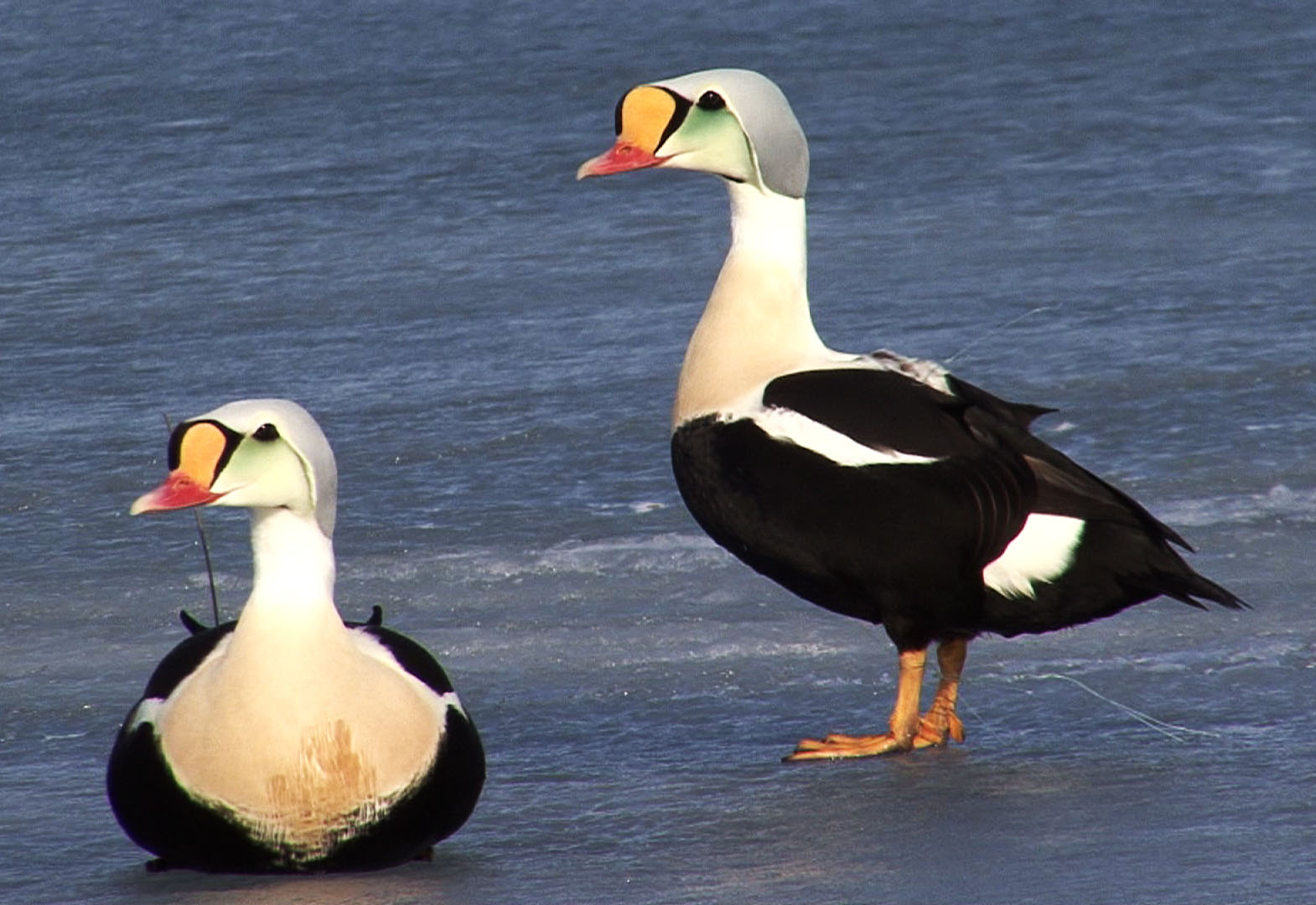
King eider(Somateria spectabilis)
Phylum —chordata
Class — aves
Order — anseriformes
Family — anatidae
Genus –somateria
Appearance
The king eider is a large sea duck, measuring 50–70 cm (20–28 in) in length with a wingspan of 86–102 cm (34–40 in). Males are, on average, heavier than females, with a mean weight of 1.668 kg (3.68 lb) for males and 1.567 kg (3.45 lb) for females. Like all eiders, the species is sexually dimorphic; the male is slightly larger and, in breeding plumage, much more colorful than the female. The male is unmistakable with its mostly black body, buff-tinged white breast and multicolored head. The head, nape and neck are a pale bluish grey. The cheek is pale green. The bill, separated from the face by a thin black line, is red with a white nail and a large, distinctive yellow knob. Some tertials are curved up and form "spurs" along the back.
The female is a warm brown color overall, slightly paler on the head and neck. The feathers on her upperparts and flanks are marked with blackish chevrons, while those on her neck and head bear fine black streaks. She has a buffy spot at the base of her bill and a buffy eye ring which extends into a downward curving stripe behind her eye. Her bill is variously described as black or grey, and her legs and feet are greenish grey.
Juvenile birds are greyish brown. Late in their first autumn, young males moult into a darker plumage, with white on the breast and rump; it takes them three years to achieve full adult plumage.
Habitat
The king eider is circumpolar, found throughout the Arctic. It breeds on the Arctic coast of Alaska, Canada, Greenland, Svalbard and Russia, using a variety of tundra habitats. It winters in arctic and subarctic marine areas, most notably in the Bering Sea, the west coast of Greenland, eastern Canada and northern Norway. It also occurs annually off the northeastern United States, Scotland and Kamchatka.
Behavior
King eiders are primarily seafaring ducks found swimming and diving using their large webbed feet, though they are capable of walking and running on land and ice.
Like most ducks, king eiders perform rapid flight and typically fly in flocks less than 100 m above the ground, water, or ice. This species is highly gregarious—flocks may reach 10,000 individuals or more during migrations but during the rest of the year, smaller flocks (less than 100 individuals) are numerous.
Spring migration begins when favorable weather conditions arrive, generally taking place in May. King eiders molt their primary feathers soon after they arrive on the breeding grounds, but prior to laying eggs. During August through October adult birds molt their body feathers. The primaries are re-molted in September and October in preparation for the fall migration which takes place during November and December.
King eiders are diurnal species, which means, during the summer months of the high arctic they are active for nearly 24 hours each day.
King eiders are highly social except during the breeding season when agonistic behavior is common when paired. Males are usually more aggressive than females and may, for example, display chin-lifting (rapidly lifting and exposing chin briefly), chasing, upward stretching (lifting head vertically and rearing out of the water exposing dorsal surface), and reaching (stretching head out over the water while arching back). These displays may also be directed at avian predators.
Diet
The king eider's foraging strategies change depending on the season. For much of the year, it is at sea; there, it dives for benthic invertebrates. During the breeding season, it does more of its foraging on freshwater lakes and ponds, where it dabbles, feeding primarily on small invertebrates plucked from the surface of the water. It feeds on mollusks, crustaceans like king crabs, and on sea urchins, starfish and sea anemones.
Reproduction
The female builds a scrape nest on the ground, usually near water. She lines it with vegetation and down feathers from her own body. She lays a clutch of 2–7 eggs, which she alone incubates for 22 to 23 days. The young are raised collectively by the females.
Lifespan of these birds – about 19 years.
Incaptivity
Eiders live and breed only in the wild. However, people have learned to interact with this bird, mainly to get valuable down, which eiders line their nests.
Every year, expeditions are sent to the breeding grounds of the eiders. Fluff collectors look for birds ' nests and carefully collect fluff. This can be done only before the chicks appear or after they leave the nest. The down in the nest is replaced by hay. The bird calmly returns to the nest after such a replacement and continues to hatch eggs.
 Russian
Russian
 English
English
























